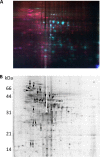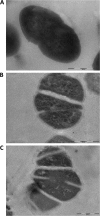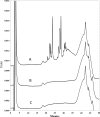SalB inactivation modulates culture supernatant exoproteins and affects autolysis and viability in Enterococcus faecalis OG1RF
- PMID: 22563054
- PMCID: PMC3393493
- DOI: 10.1128/JB.00376-12
SalB inactivation modulates culture supernatant exoproteins and affects autolysis and viability in Enterococcus faecalis OG1RF
Abstract
The culture supernatant fraction of an Enterococcus faecalis gelE mutant of strain OG1RF contained elevated levels of the secreted antigen SalB. Using differential fluorescence gel electrophoresis (DIGE) the salB mutant was shown to possess a unique complement of exoproteins. Differentially abundant exoproteins were identified using matrix-assisted laser desorption ionization-time of flight (MALDI-TOF) mass spectrometry. Stress-related proteins including DnaK, Dps family protein, SOD, and NADH peroxidase were present in greater quantity in the OG1RF salB mutant culture supernatant. Moreover, several proteins involved in cell wall synthesis and cell division, including d-Ala-d-Lac ligase and EzrA, were present in reduced quantity in OG1RF salB relative to the parent strain. The salB mutant displayed reduced viability and anomalous cell division, and these phenotypes were exacerbated in a gelE salB double mutant. An epistatic relationship between gelE and salB was not identified with respect to increased autolysis and cell morphological changes observed in the salB mutant. SalB was purified as a six-histidine-tagged protein to investigate peptidoglycan hydrolytic activity; however, activity was not evident. High-pressure liquid chromatography (HPLC) analysis of reduced muropeptides from peptidoglycan digested with mutanolysin revealed that the salB mutant and OG1RF were indistinguishable.
Figures







Similar articles
-
The Enterococcus faecalis exoproteome: identification and temporal regulation by Fsr.PLoS One. 2012;7(3):e33450. doi: 10.1371/journal.pone.0033450. Epub 2012 Mar 12. PLoS One. 2012. PMID: 22428053 Free PMC article.
-
Pleiotrophic effects of 2 Enterococcus faecalis sagA-like genes, salA and salB, which encode proteins that are antigenic during human infection, on biofilm formation and binding to collagen type i and fibronectin.J Infect Dis. 2006 Jan 15;193(2):231-40. doi: 10.1086/498871. Epub 2005 Dec 12. J Infect Dis. 2006. PMID: 16362887
-
Characterization of Acp, a peptidoglycan hydrolase of Clostridium perfringens with N-acetylglucosaminidase activity that is implicated in cell separation and stress-induced autolysis.J Bacteriol. 2010 May;192(9):2373-84. doi: 10.1128/JB.01546-09. Epub 2010 Feb 26. J Bacteriol. 2010. PMID: 20190047 Free PMC article.
-
Fsr-independent production of protease(s) may explain the lack of attenuation of an Enterococcus faecalis fsr mutant versus a gelE-sprE mutant in induction of endocarditis.Infect Immun. 2005 Aug;73(8):4888-94. doi: 10.1128/IAI.73.8.4888-4894.2005. Infect Immun. 2005. PMID: 16041002 Free PMC article.
-
Physiological and molecular aspects of bile salt response in Enterococcus faecalis.Int J Food Microbiol. 2003 Dec 1;88(2-3):207-13. doi: 10.1016/s0168-1605(03)00182-x. Int J Food Microbiol. 2003. PMID: 14596992 Review.
Cited by
-
Extracellular SalB Contributes to Intrinsic Cephalosporin Resistance and Cell Envelope Integrity in Enterococcus faecalis.J Bacteriol. 2017 Oct 31;199(23):e00392-17. doi: 10.1128/JB.00392-17. Print 2017 Dec 1. J Bacteriol. 2017. PMID: 28874409 Free PMC article.
-
The Phosphatase Bph and Peptidyl-Prolyl Isomerase PrsA Are Required for Gelatinase Expression and Activity in Enterococcus faecalis.J Bacteriol. 2022 Jul 19;204(7):e0012922. doi: 10.1128/jb.00129-22. Epub 2022 Jun 3. J Bacteriol. 2022. PMID: 35657705 Free PMC article.
-
Involvement of Enterococcus faecalis small RNAs in stress response and virulence.Infect Immun. 2014 Sep;82(9):3599-611. doi: 10.1128/IAI.01900-14. Epub 2014 Jun 9. Infect Immun. 2014. PMID: 24914223 Free PMC article.
-
Lytic bacteriophages facilitate antibiotic sensitization of Enterococcus faecium.Antimicrob Agents Chemother. 2023 May 1;65(5):e00143-21. doi: 10.1128/AAC.00143-21. Epub 2021 Mar 1. Antimicrob Agents Chemother. 2023. PMID: 33649110 Free PMC article.
-
Drosophila host model reveals new enterococcus faecalis quorum-sensing associated virulence factors.PLoS One. 2013 May 29;8(5):e64740. doi: 10.1371/journal.pone.0064740. Print 2013. PLoS One. 2013. PMID: 23734216 Free PMC article.
References
-
- Arias CA, Cortes L, Murray BE. 2007. Chaining in enterococci revisited: correlation between chain length and gelatinase phenotype, and gelE and fsrB genes among clinical isolates of Enterococcus faecalis. J. Med. Microbiol. 56:286–288 - PubMed
-
- Biavasco F, et al. 1996. In vitro conjugative transfer of VanA vancomycin resistance between enterococci and listeriae of different species. Eur. J. Clin. Microbiol. Infect. Dis. 15:50–59 - PubMed
-
- Bonten MJ, Willems R, Weinstein RA. 2001. Vancomycin-resistant enterococci: why are they here and where do they come from? Lancet Infect. Dis. 1:314–325 - PubMed
-
- Breton YL, et al. 2002. Isolation and characterization of bile salts-sensitive mutants of Enterococcus faecalis. Curr. Microbiol. 45:434–439 - PubMed
Publication types
MeSH terms
Substances
Grants and funding
LinkOut - more resources
Full Text Sources
Molecular Biology Databases

